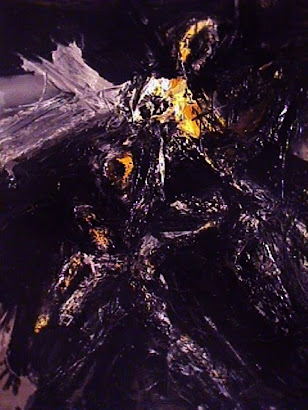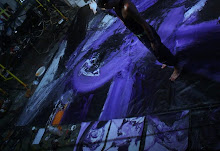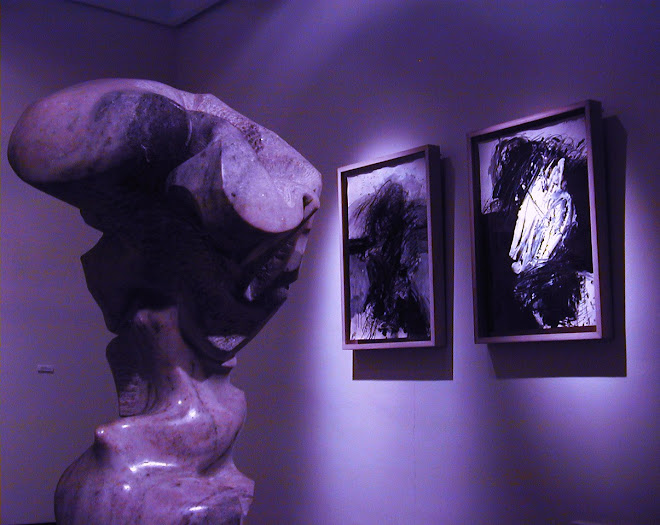.
.
.
Brief Considerations
on
Latin American Contemporary Art
Gustavo Fares
The meeting of two worlds, the so-called first and the others, produces new and original cultural manifestations that can be fruitfully explored through visual images. Images, or embodied meanings -- as Arthur Danto calls them -- incarnate an element that is formed by, but is not part of, the original cultures, yet belongs to both/all of them. In the case of Latin America, the incorporation of new and sometimes foreign or imported cultural elements, particularly from Europe and the U.S., contributes to shaping the continent's culture and cultural identity, which becomes problematized as it is rendered "impure." I am interested in exploring the ways in which contemporary art from the United States relates to that of Latin America. To do this, I propose to examine the notions of modernity and of post-modernity as they apply to the Latin American context(s), as well as their usefulness, or lack of thereof, to understand the continent's artistic manifestations. Latin American art, when related to that of the United States from a post-modern perspective, can provide a better understanding of the ways in which contemporary art becomes trans-culturalized and, in the process, enriched. As contemporary art is closely related to modernism and its successors, I believe it is necessary to utilize this terminology to analyze and understand Latin America’s contemporary art. Fruther, it becomes necessary to take into account the European avant-garde and the new cultural encounter between Europe and America that is taking place during this century. It is possible to consider the categories of the "modern" and the "post-modern" as stylistic manners in the history of art, which have appeared in diverse times and places, as the "baroque" or "mannerism" have in the past. It is also possible to think of modernism and post-modernism as decidedly temporal periods, rooted in specific times, and to agree that modernism and its successors signal radically new and different manners of conceiving the world. We can also take into account both notions and argue that post-modernism satirizes and plays with the surfaces of modernism in the same manner as the styles in decadence in general do with their predecessors, such as Hellenism with the Greek art. But we might also conclude that, at this end of the millennium, the "game" post-modernism plays with the avant-garde has a certain unique flavor, in the sense that it seems to take place at the end of a process, in as much as the role of art and of the artistic object are concerned. Indeed, so different and unique is the game at hand that some authors have been speaking for some time now of the end of art, of the discipline entering a post-historic phase, one in which the ideas it generates have been exhausted, even though the praxis has not. It is more accurate in my view to think of a closure rather than an end -- a way of signaling that we will continue to produce art-objects but in a different fashion than the ones we got used to up to the first half of this century. It seems that the almost linear succession of styles, each one more original that its predecessor, is now over. In the not-so-distant past, the quality and success of art and art-objects was easy to determine. It was only necessary to follow a rule, in as much as one existed, against which it was relatively easy to compare the quality of the object in question. This referential and objective rule was the understanding that the role and function of art-objects was to be "like the real thing," a mimesis of the world and its objects. In this conception, in which the work was good if it looked like the external object, an evolution of the art was postulated through diverse cultures, times, and places, in which, progressively, there was to be a development of such magnitude that would ultimately produce a faithful reproduction of the model "as it was." The notion of likeness as a golden rule appeared in the Renaissance and continued until recently. Even Impressionism, with all the scandals and controversies it generated around the turn of the century Parisian milieu, was in fact aiming at faithfully rendering the objective word, this time following the laws of optics rather than the illusory perspective and the Chiaroscuro inherited from the Renaissance. Art as an instrument of reproduction of the world "out there" had a very specific purpose: to tell a story, a storia, in the Albertian manner (who compared painting to theatre) or to present an ideal. The art-object had to be better than the real world; if not, why reproduce it? Renaissance art also had a clear social function of reproducing hegemonic cultural structures, a role closely related to the emergence of the new nation states and to the only international corporation and the main client at that time, the Church.Beginning with the Romantic Movement, in which personal emotion counted more than objective representation, and, more specifically, since the 19th century, the art-object started to be considered inferior to the real world. With this devaluation of the art-object, which lost its clear social function, it became necessary to justify its existence as a means of educating the populace and as a way of alleviating social tensions that were evident with the early industrialization of the nation states. Because of the industrialization that took place in 19th century societies in Western Europe, there arose a need to locate a domain set apart from money and work, unencumbered by social tensions, a pre-capitalist locus out of the market forces that dominated the economy. Art fulfilled that role. This isolation of art allowed the discipline and its laborers not only to face up to the challenge brought up by the massive production of objects, but also to try to remain relevant after the advent of photography. The "progress" of art toward a final and reachable goal of faithfully rendering the world lost its appeal and its justification when new technologies of representation, photography and the movies, took the challenge of representing the world "as it was" and did it better than painting. Thrown out of the job of faithfully recording and rendering reality, the function of art became one of expression. The evolutionary conception of the discipline was then replaced by the subjectivity implicated by the notion of personal expression, which in a way asserted that there was no objective rule to judge an art-object as the likeness to the model used to. The concept of evolution was left aside and diverse movements and works became valid manifestations of expression. These movements did not have continuity or affirm one common goal, but were rather opposite to each other, replacing one another at an increasingly rapid pace. The succession of "isms" at the end of the 19th century and beginning of the 20th century appeared as exclusive and universally valid tendencies at the same time that they became extremely restricted in their times, spaces and audiences. The justification of art as a means of expression is still with us, as it was made clear with the revival of Expressionism in the Neo-Expressionism forms of the 1980s. The understanding of art that went from being evolutionary to being expressive was once again transformed in the present century. Neither of these justifications seem to account for the activity taking place and the objects being produced in the contemporary art world. What "expression" is to be found in Picasso’s guitars? What are they expressions of? And if they express feelings, then one must conclude that Picasso and Braque had very similar feelings, even though they were completely different individuals. Moreover, what does Duchamp’s shovel, or any of his ready-mades express? Given that these art-objects could not be explained using the paradigms of likeness nor of expression, it was necessary to search for another explanation for artistic phenomena. Arthur Danto, who takes into account resemblance and expression as cultural phenomena that reflect different epochs and ways of thinking, proposes one explanation. According to him, 20th century modernism abandoned the paradigms of likeness and of expression, taking art itself as the model or material upon which to comment. In a way, then, art came to an end, not as an activity, but as a source of fresh understandings of the world, and began to deal with itself as the material at hand. Thus, according to Danto, art seems to have attained its objective, the manifestation of its own philosophy, and upon reaching it, appears to have lost its driving force toward some reachable goal. In a certain sense art has returned to a pre-modern domain, pregnant with extra-artistic references, the same references that modernism and the avant-garde purged from the art-object and the art world in order to concentrate on purely aesthetic concerns.In this pre- or post-modern understanding of the art-object and art disciplinel, it is fitting to ask whether the cultural logic that appears in the industrialized world with the assimilation of the avant-garde and its disappearance as such have any validity in a different context, such as Latin America’s. There are several different answers to this question. The American left sees in post-modernism a way to revitalize its ideals and to integrate them into the Latin American context. In this frame of reference, there is a celebration of the eruption of mass culture in its populist aspects rather than in the consumerism that characterizes it and a looking forward to a destabilization of the categories that have been used in cultural analysis until the present time. Other critics consider post-modernism as the latest trend imported from the so-called first world by Latin American countries and élites, a new series of cultural artifacts readily embraced by the cultural élites of the different countries. Whatever the case, it is clear that in this post- or pre- modern domain, art schools and styles are not expected to be uniformed or monolithic. Rather, there is an abundance of different artistic manifestations that take place simultaneously.To the destabilization of one unique totalizing position, the post-modern debate adds the conflicts and dialogues between the national and the global, the native culture and the Other, the high culture of the élites and the popular one, the center and the periphery. Moreover, post-modernity questions a unidirectional relationship between center (be it Europe or the United States) and periphery, proposing the existence of exchanges in either and both directions at the same time. And this could not be otherwise. To accept the unidirectionality of influences between center and periphery would be to take a 16th century, European point of view, one that creates America in order to possess it (Rabasa). Indeed, to accept handed-down definitions of the spaces occupied, and of the relationships defined, by the center and the periphery would be a risky proposition. Peripheral areas are defined in relation to the centers, the main differences between both being temporal, as well as spatial. Besides being physically located in different areas, center and periphery experience time in distinct ways, at different speeds: fast in the former, slower and lagging in the latter. However, being far away from the centers, farther away than, let's say, the provinces, "the periphery is more open to impulses of any kind, which are less frequent there but are more eagerly accepted as a material from which to choose" (Bialostochi 53). And, culturally speaking, we can challenge the monolithical conception of a center identified with industrialized societies against a periphery incarnated in third-world countries if we only compare the much faster time frames of places like Mexico City or Buenos Aires to some areas of the U.S., such as Lynchburg, Virginia, where I live.??Precisely by keeping in mind local phenomena, be they centered or peripheral, post-modernity pays attention to diverse messages, sometimes contradictory, sometimes politically loaded, that divide society and its culture. If this is so, the politics of North American society, for example, are revealed in their art, which reproduces in parallel fashion its cultural debates. It becomes possible then to speak in the U.S. of a feminist art, an ecological art, an art of races, an art of minorities (Asian, Hispanic, African-American), dividing the cultural spectrum according to the same lines that divide the social and political realms of American society. In this sense, the current art makes visible a series of issues typical of a particular time and place in a sort of "spiritual metabolism" that escapes the concept of an art which "progresses" and "advances," proposing instead a "post-historical" praxis wherein the value of novelty is not as important, or relevant, as that of integration. The aforementioned characteristic of the art world in first-world societies, the lack of a unified school or movement, the differences between center and peripheral spaces and times, and the specificity of the artistic enterprise to the cultural and societal context where it develops, can be relevant when examining the events shaping the art world in other spaces, in the so-called "margins" of development. To these traits, we must add a new one, peculiar to "marginal" societies. In these areas information is instantaneously received, while general technological advances take much longer to arrive, making the hiatus between what is known and what is experienced far greater than in post-industrial societies. I propose that Latin American contemporary art needs to, and in fact does, deal with two sets of issues: on the one hand, it reflects the local conditions of the society where it is produced; on the other, it transforms and recycles the information received from the "centers" of economic development, such as the United States, which are not necessarily or always the centers of cultural development. This double play between the local and the global, the centers and the margins, between what was (and is) oppressed and the oppressor's cultural forms, and among the myriad of images and art schools and cultures available to the viewer/voyeur/consumer, is reflected in contemporary Latin American art. Its manifestations bear witness to both the lack of a single visual school and to the interactions between the local and global flows of information. This is not new, of course. Since the XIX century, Latin America in general has been dealing with the interplay of these two tendencies. The war of Independence against Spain, for instance, started not so much because of a need felt by the masses of the continent as much as by the influence of French ideology in the Creole élite that governed the urban centers. Everybody, both in Latin America and in Europe, however, felt the result. The same process of a multidirectional interplay of cultural manifestations is taking place now.As in the past, non-native ideas help define and shape the image of the continent, while the native contexts modify and transforms them, creating in the process new and original cultural expressions. Moreover, this time the circulation of ideas coming from, and going to, different places and societal strata is challenging the hegemony of a single position. In this kind of Latin American context, the term "post-modernism" acquires connotations and denotations different from those in the American academy, up to the point of being possible to speak of an anti-, more than a post-, modernity. This is the case especially in Latin America, where the critical assessment of the ways in which modernity operated is necessary and inevitable. This critical assessment stresses that in the North the term "modernity" was expressed in democratic structures and in the Fordist manner of production, whereas, in the South, democracy languished and injustice prevailed. The question, it seems, is not the possibility of post-modernity in Latin America, but the several ideological loads this post-modernity could assume. There is not, it seems, one post-modernism, but as many as we want/need, with different emphases, political ends and means, currently taking place in Latin America; and it is our task as critics and as artists to forge the one(s) that would better serve us. It is my firm belief that contemporary Latin American artists and their creations incarnate these processes at the present time.
.
Presentación 2016 del libro en DAIN Usina Cultural
-
Con motivo de la primera presentación del 2016 de mi libro, *A PARTIR DE
LAS AUSENCIAS. UNA EXPERIENCIA CON EL ARTE ARGENTINO CONTEMPORÁNEO*, los
invito a...





















